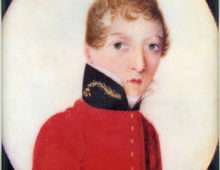Tagged with Poverty
Resource : Crompton’s spinning mule
The spinning mule was invented by Samuel Crompton in 1779. It revolutionised textile production by vastly increasing the amount of cotton that could be spun at any one time. But this also meant textile manufacturers no longer needed to pay individual spinners to create spindles (wooden rods) wound with cotton thread, as just one operator could now use the machine to spin hundreds of spindles at once.
Resource : View of New Lanark by John Winning
Throughout the 1800s Britain became a busy industrial nation. People migrated in increasing numbers from the countryside to towns and cities to work in new factories and mills. Working conditions were poor and dangerous, injuries from machinery were common and workers – including children as young as six – worked long hours. Overcrowding, limited diets and polluted water led to widespread disease and early death. New Lanark, a village on the River Clyde near Glasgow, was a revolutionary industrial and housing complex, combining a cotton mill with purpose-built housing, education and social care for its workers and their families. The ideas put into practice here marked the beginning of cooperative socialism.
Resource : The Blessings of Peace or the Curse of the Corn Law
This satirical cartoon, by George Cruikshank, is a comment on what became known as the Corn Laws – one of the most unpopular pieces of legislation ever to be introduced by the British Government.
Resource : The life and adventures of Michael Armstrong, the factory boy by Frances Trollope
This illustrated novel by Frances Trollope (1779-1863) was published in monthly parts in 1840, costing one shilling apiece. It tells a fictional story of Michael Armstrong, based on the real-life hardships, exploitation and suffering of children in the workplaces of the Industrial Revolution. It was the first novel about industrial life in Britain and made an important contribution to the campaign to reform conditions for workers – especially children.
Resource : The Apprehensive Man
The Great Famine was a period of mass starvation and disease in Ireland. It lasted from 1845 to 1851, killing one million Irish people and leading to the migration of perhaps two million more. It became a watershed in Ireland’s history, permanently changing the demographic, political and cultural landscape. The ‘Apprehensive Man’ is one of a series of five bronze sculptures in the ‘Arrival’ series created by Irish artist Rowan Gillespie in 2007 and situated in Ireland Park in Toronto, Canada. It marks the arrival of thousands of starving Irish migrants in 1847.
Resource : Tolpuddle Martyrs Sculpture
In 1834, six farm workers were arrested and transported to Australia as a result of banding together to improve the miserable wages of farm labourers. The maltreatment of the ‘Tolpuddle Martyrs’, as they became known, helped pave the way for the creation of trade unions and the protection of employees’ rights.
Resource : Ireland’s uprising (1798)
The move, led by the United Irishmen, to drive through a fully-fledged anti-colonial rebellion against British rule, inspired by the American and French revolutions.
Resource : French revolution
The fevered fight for liberté, egalité, and fraternité in France, bringing with it a spate of violent and bloody wars across Europe and sending shockwaves of fear through the British establishment.
Resource : British politics in the Age of Revolution
The continued calls for the reform of British politics and representation of marginalised sectors of society, and the establishment’s unprecedented measures to restrict and suppress these ‘radical’ ideas and demands.


